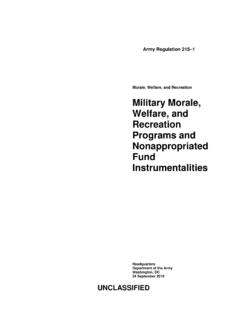Transcription of The Basics of Risk-Need-Responsivity
1 The Basics of Risk-Need-Responsivity : PCCD Richard Podguski, PA Board of Probation & Parole September 27, 2016 Slides adapted from Podguski PBPP Presentation and D Amora RNR 101 Presentation for Council of State Governments So what is RISK-NEEDS-RESPONSIVITY? Risk Principle: Who to target. Match the intensity of individual s intervention to their risk of reoffending. Focus on Medium to High-Risk Offenders. Needs Principle: What to target. Target criminogenic needs. Individuals assessed needs. Responsivity Principle: How to target. Tailor the intervention to the learning style, motivation, culture, demographics, and abilities of the individual.
2 Address the issues that affect individual s ability/openness to participate in and benefit from delivered treatment and services. Generally use Cognitive-Behavioral Intervention (CBI) methods. In a Risk = WHO Need = WHAT Responsivity = HOW More than half of all correctional programs are deemed ineffective (Latessa). Not all individuals have the same risk of recidivating. Limited resources require us to make choices about how to spend time and resources. Focusing on low-risk individuals can INCREASE chances of recidivism. Research has shown that implementing RNR practices DECREASES recidivism. Why does RNR matter? The Risk Principle: Matching intensity of intervention to risk of re-offending What is Risk?
3 Risk is the likelihood that an offender will engage in future criminal behavior. Risk is determined by static factors and dynamic factors. Static factors, based on criminal history, cannot be decreased by intervention. Dynamic risk factors, also called criminogenic needs, can be decreased by intervention. Examples of these include: Criminal Thinking, Temperament, Substance Abuse, Use of leisure Time, Family Dynamics, and Education/Employment. Risk Is Not: Determined by Clinical Judgment Determined by the Offense Committed A measurement of the dangerousness of the Offender or likelihood of violence Related to an Offender s Motivation to Change Employing the Risk Principle Use Actuarial Assessments to Determine Which Offenders are High, Medium, or Low Risk Allocate Resources Toward Medium and High Risk Offenders Minimize Resources for Low Risk Offenders Refrain from Playing it Safe The Need Principle: Target the factors most linked with recidivism.
4 Criminogenic Needs, or dynamic risk factors are: Best Determined by Actuarial Assessments Dynamic Needs Related to Likelihood of Reoffending Include Top and Lesser Needs Able to Reduce Recidivism if Addressed Criminogenic Needs are not: Self-Esteem, Artistic Skills, Physical Condition, Lower Economic Origins Criminogenic Needs (Adapted from Latessa, Andrews & Bonta, and Gendreau) Criminogenic Need Response Anti-social cognition Reduce anti-social cognition, recognize risking thinking and feelings, adopt an alternative identity Anti-social companions Reduce association with criminals, enhance contact with pro-social Anti-social personality (temperament) (Indicators on Next Slide)
5 Build problem solving, self management, anger management, and coping skills Family and/or marital Reduce conflict, build positive relationships and communication, enhance monitoring/supervision Criminogenic Needs (Adapted from Latessa, Andrews & Bonta, and Gendreau) Criminogenic Need Response Substance abuse Reduce usage, reduce the supports for abuse behavior, enhance alternatives to abuse Social Achievement: Education/Employment Enhance performance rewards and satisfaction Enhance performance rewards and satisfaction leisure and/or recreation Enhance involvement and satisfaction in pro-social activities The Responsivity Principle: How to Target Account for individuals strengths, abilities and learning styles, traumatic history, and other relevant considerations when designing treatment goals and service delivery.
6 General Responsivity Involves the Use of: Cognitive-Behavioral Techniques Motivational Interviewing Natural Support Systems Measurement Feedback Specific Responsivity Involves Consideration of: Static Factors: Learning Style, Gender, Culture, Age, IQ Changeable Factors: Motivation Levels, Self-Esteem Why use Evidence-Based Practices in Criminal Justice Settings? Because they: Put an end to risky trial and error approaches with offenders Build on the lessons learned from our predecessors Promote consistency and responsible practices Allow us to invest resources wisely and to achieve desired outcomes. Ensure internal and external stakeholders understand our practices and decisions Increase accountability and improve our chances of reducing crime Maximize the likelihood of offender success Challenges of Implementing Evidence-Based Practices?
7 Requires a dedicated commitment to change at all levels of an organization Often requires increased emphasis on accountability, both individually and collectively Requires reconsideration of current practices and letting go of the that s always how we ve done it philosophy May result in resistance as some people are forced out of their comfort zone Recommended Guidelines for Implementing Effective Interventions I. Limit new projects to mission-related initiatives. II. Assess progress of implementation processes using quantifiable data. III. Acknowledge and accommodate professional over-rides with adequate accountability. IV. Focus on staff development, including awareness of research, skill development, and management of behavioral and organizational change processes, within the context of a complete training or human resource development program.
8 V. Routinely measure staff practices (attitudes, knowledge, and skills) that are considered related to outcomes. VI. Provide staff timely, relevant, and accurate feedback regarding performance related to outcomes. VII. Utilize high levels of data-driven advocacy and brokerage to enable appropriate community services Key Steps to Implementing Evidence-Based Practices 1. Identify the problem and desired outcomes 2. Locate the research that addresses the problem 3. Critically evaluate the evidence identified in the research 4. Assess the extent to which current practices are consistent with the identified evidence based practices 5. Develop an implementation strategy and implement the program 6.
9 Evaluate the impact of new practices on desired outcomes Key Steps to Implementing EBP Local Initiatives Employing RNR Model Philadelphia PBPP CSG Employment Model Other Models Philadelphia Reentry Coalition Coalition Make-Up -22 city/county agencies -5 state agencies -3 federal agencies -53 non-profit agencies (mostly providers) -5 academic organizations Over 175 individuals have attended general body meetings since April of 2015. Philadelphia Reentry Coalition Coalition s Committee Structure: Steering Committee provides overall leadership Focused on Function: Community Engagement Identifying organizations in Philly lead by returning citizens, ultimately to try to support Launching the Returning Citizens Think Tank, 6-month fellowship, returning citizens nominated by their organizations Data and Metrics Calculating recidivism metrics for Philadelphia Will be administering a survey on data-collection and data-sharing RNR (See Next Slide)
10 Policy Developing a template to track policy issues that relate to reentry Funding Developing a letter of support policy/process Facilitating collaboration in pursuit of funding opps Focused on Issue Areas Juvenile Life Without Parole Trying to share information and create a collective strategy to support the needs of juvenile lifers returning to Philadelphia Education Thinking about education issues in reentry, educating other stakeholders and mapping the system. Ex: may work on producing materials so that when education is stipulated in sentencing, it makes sense given how adult education system works/ needs of adult learners Employment Educating committee members about issues that relate to reentry and employment, such as CSG resource -Allocation and Service-Matching Model, and also educating other stakeholders, ie, Employment and Reentry 101 Training Health (to launch in October) Housing (pending)















